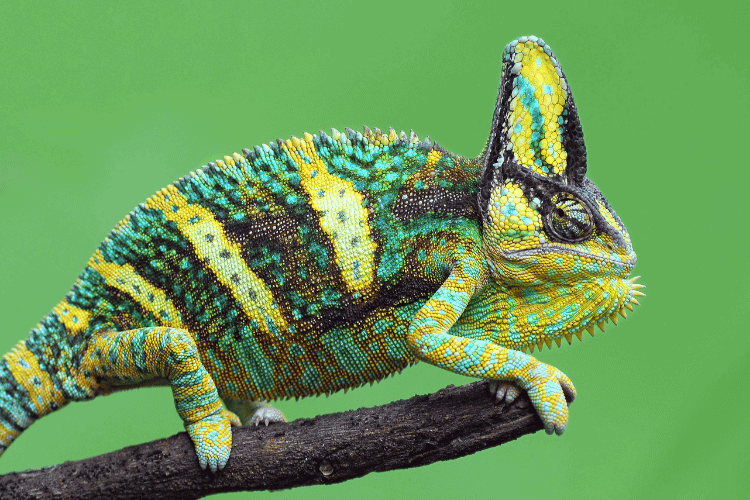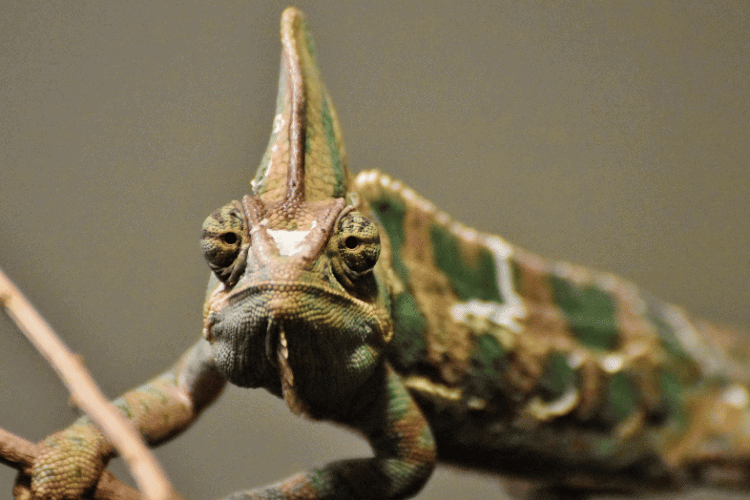Veiled chameleons are charismatic, color-changing critters that have costume changes than a Kylie Minogue concert.
Veiled chameleons are known for their uncanny ability to change colors and blend into their surroundings.
And a big part of this is their shedding process, a natural part of their life that’s as intriguing as it is essential. But, how often do veiled chameleons shed?
Let’s dive in.
Overview of Veiled Chameleons

Veiled chameleons (Chamaeleo calyptratus) are amazing reptiles known for their unique characteristics and captivating personalities.
Native to the mountainous regions of Yemen and Saudi Arabia, these chameleons have become popular as exotic pets worldwide.
Veiled chameleons are recognized for their striking appearances, featuring a casque (helmet-like structure) on their heads, independently moving eyes, and the ability to change colors for communication and temperature regulation.
They have prehensile tails, allowing them to grasp branches and navigate their arboreal habitats with ease.
These reptiles are primarily insectivorous, enjoying a diet of various insects, making them skilled hunters. Veiled chameleons also require access to UVB lighting and need proper hydration to thrive.
Chameleons require specialized care, including maintaining humidity levels, a clean habitat, and a suitable diet to ensure their well-being in captivity.
Veiled Chameleon Shedding Explained
Chameleons are able to shed their skin, revealing a fresh layer underneath. This incredible process is a vital part of their growth and overall well-being.
Shedding in Patches
Picture this: you have a favorite pair of jeans, and as you grow taller, instead of buying a new pair, you can simply peel off a portion of the old jeans and reveal fresh ones underneath. Well, veiled chameleons do something quite similar with their skin.
Instead of shedding their entire outer layer at once, they do it in patches. These patches of shed skin can appear as small, white spots on various parts of their body, such as their legs, tail, and face. It’s as if they’re gradually unzipping an old, snug-fitting jacket, letting their new, vibrant skin emerge.
Skin as a Snack
Now, here’s where the story gets a bit gross. After they’ve successfully shed, veiled chameleons often consume their own old layer of skin!
At first glance, this may seem a tad strange, but there’s a fascinating reason behind it. By eating their dead skin, chameleons reclaim valuable nutrients, particularly
This recycling process is an ingenious adaptation of nature, ensuring they don’t lose essential resources during the shedding process.
So, if you catch your chameleon enjoying a post-shed snack, know that it’s all part of their brilliant survival strategy.
Shedding Frequency
The shedding frequency of veiled chameleons isn’t a one-size-fits-all affair. It depends on their age and rate of growth. Juvenile chameleons, in their early stages of life, are on a rapid growth trajectory.
To accommodate this growth, they shed more frequently, typically every 3-4 weeks. It’s like they’re shedding their “baby skin” as they inch closer to adulthood. These frequent shedding events are a reflection of their dynamic development.
As chameleons mature into adults, shedding becomes less of a regular occurrence. You’ll notice fewer shedding events as they reach their full size and body weight.
Shedding Signs and Behaviors
Veiled chameleons might not be able to communicate in words, but they have their own unique ways of letting you know that it’s time for a little wardrobe change. Understanding these signs and behaviors can help you support your chameleon during their shedding process.
Dull and Milky Skin
Imagine your veiled chameleon’s skin as a vibrant, ever-changing canvas. However, as shedding time approaches, you might notice a noticeable shift.
Their normally vivid and eye-catching colors may become muted, and their skin can take on a milky or cloudy appearance. This transformation happens because the old skin layer is getting separated from the fresh one beneath.
Reduced Appetite
Just like we might not have much of an appetite when we’re feeling a bit off, your chameleon may show a decreased interest in food as shedding day draws near.
This temporary loss of appetite is entirely normal and nothing to worry about. In fact, it’s your chameleon’s way of conserving energy for the upcoming shedding process.
Restlessness
Your veiled chameleon might exhibit some interesting behaviors when they’re getting ready to shed. They may rub their body against rough surfaces within their enclosure, like branches or rocks.
This behavior is a bit like us using a loofah to exfoliate our skin; it helps loosen the old skin, making it easier to shed.
Additionally, you might find them seeking out hiding spots more frequently during this time. This instinctual behavior allows them to feel safe and secure while they undergo the transformation.
Observation is Key
As a devoted pet chameleon owner, your role during this shedding phase is to be an attentive observer. By paying close attention to your chameleon’s appearance and behavior, you can anticipate when the shedding process is imminent.
This knowledge empowers you to make the necessary adjustments to ensure their comfort and well-being.
Shedding Duration
Now that you’re familiar with the signs and behaviors that herald your veiled chameleon’s impending shed, let’s talk about the timeline of this remarkable process.
Shorter for Juveniles
Juvenile veiled chameleons, in their early stages of life, tend to shed more frequently. Typically, they shed every 3-4 weeks, though the exact timing can depend on their rate of growth.
This frequent shedding is a reflection of their rapid development as they grow into adults. Don’t be surprised if you find small, delicate patches of skin in their enclosure quite often during this phase.
Longer for Adults
As your veiled chameleon matures into adulthood, shedding becomes less frequent. You’ll notice fewer shedding events as they reach their full size and body weight.
While juveniles might complete the shedding process in just a few hours, adult chameleons can take several days to shed fully. The extended duration is nothing to be concerned about.
Caring for Your Chameleon During Shedding
It’s time to focus on what you can do as a responsible pet owner to ensure your chameleon’s comfort and well-being during this unique process.
Maintaining Adequate Humidity
One of the most crucial aspects of caring for your chameleon during shedding is humidity. These creatures require a specific level of humidity in their environment to facilitate the shedding process.
Aim for a humidity level of around 50-70% in their enclosure. You can achieve this by misting their habitat regularly with warm water. Be sure to provide a humidity gauge to monitor levels accurately.
Offering Hiding Spots
Chameleons are naturally solitary creatures, and they might become a bit more reclusive during shedding.
Providing hiding spots, such as dense foliage or branches, allows them to retreat and feel safe while they undergo the transformation.
These hiding spots mimic their natural environment and reduce stress.
Maintaining a Healthy Environment
As always, maintaining a clean and sanitary enclosure is essential for your chameleon’s overall health.
Remove any leftover shed skin promptly, as old skin debris can lead to health issues, including respiratory infections.
Regularly clean and disinfect the enclosure to ensure your chameleon’s surroundings remain hygienic.
Adequate Supplementation Levels

Veiled chameleons require a balanced diet and access to suitable supplements, particularly
Consult with a reptile veterinarian or a knowledgeable pet store associate to determine the right supplementation regimen for your chameleon.
In Summary
In the captivating world of veiled chameleons, shedding is a natural and routine occurrence that reveals the resilience and resourcefulness of these unique reptiles.
As you’ve learned, this process involves shedding old skin in patches, often followed by a curious snack on their own discarded layers. The frequency of shedding varies with age, happening more often in juveniles and less frequently in adults.
Recognizing the signs and behaviors associated with shedding, such as dull skin and reduced appetite, empowers you to provide the necessary care and support.
While shedding may take just a few hours for the young ones, it can extend to several days for adults, emphasizing the importance of patience during this phase.
Maintaining proper humidity levels, offering hiding spots, ensuring a clean environment, and providing adequate supplementation are essential aspects of caring for your chameleon during shedding.
So, embrace the marvel of veiled chameleon shedding, and continue to provide the love and care these reptiles deserve. By doing so, you’ll contribute to the well-being of your scaly companion, ensuring a long and healthy life together.


